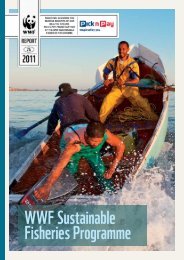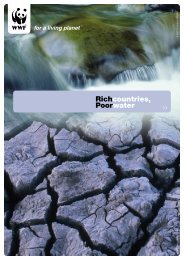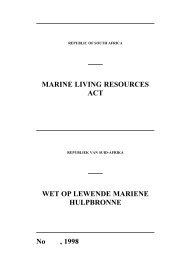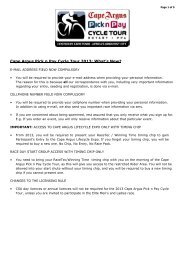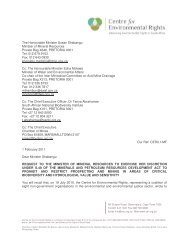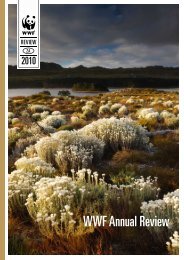State of Management of South Africaââ¬â¢s ... - WWF South Africa
State of Management of South Africaââ¬â¢s ... - WWF South Africa
State of Management of South Africaââ¬â¢s ... - WWF South Africa
- No tags were found...
You also want an ePaper? Increase the reach of your titles
YUMPU automatically turns print PDFs into web optimized ePapers that Google loves.
STATE OF MANAGEMENT OF SOUTH AFRICA’S MARINE PROTECTED AREASconsidered included night sights for night compliance operations and a laptop for MPAmanagement purposes.INFRASTRUCTURE (65%)Visitor facilities were managed and maintained by the De Hoop Collection through apartnership with CapeNature. The visitor facilities included accommodation and a restaurantand were adequate for levels <strong>of</strong> visitation. The <strong>of</strong>fice complex and the education centre in thereserve were adequate for management needs. There are three access points to the MPAfrom the land that are controlled and thus facilitated management. More staff accommodationwas required on the reserve and the development <strong>of</strong> a non-public slipway should beconsidered as the nearest slipways were only at the Breede River and at Arniston, causingdelayed responses to <strong>of</strong>fshore compliance issues. The maintenance <strong>of</strong> infrastructure wassatisfactory but could be improved on.BUDGET (67%)The budget for the management <strong>of</strong> the MPA was acceptable for most managementpurposes. The funding received by CapeNature from MCM was secured by a three yearcontract and covered approximately 60% <strong>of</strong> the personnel, operational and capital equipmentexpenses incurred by the MPA. CapeNature and other partners provide the additionalfunding that is needed.ProcessesBOUNDARY DEMARCATION (67%)The GPS co-ordinates <strong>of</strong> the boundaries <strong>of</strong> the MPA are provided in the proclamation in theGovernment Gazette. The borders <strong>of</strong> the MPA were clearly demarcated with six metre highbeacons and there were two MPA signs with maps at each <strong>of</strong> the entrances into De HoopNature Reserve. Signs providing a map <strong>of</strong> the MPA, GPS coordinates <strong>of</strong> the boundaries andthe restricted activities should be established at the two nearest slipways (Cape Infanta andArniston).PATROL AND ENFORCEMENT (50%)There were deficiencies in the capacity <strong>of</strong> staff to issue fines and implement enforcementmechanisms, and the availability <strong>of</strong> the boat and skippers to conduct <strong>of</strong>fshore enforcement.The enforcement mechanisms were not sufficient to control illegal activities as there weredifficulties in capturing poachers and securing evidence.The enforcement activities comprised <strong>of</strong> one foot patrol per week and 10 aerial patrols perannum. Two boat patrols were planned per month but only one occurred during the first half<strong>of</strong> the year due to an inadequate number <strong>of</strong> experienced skippers and maintenance andlicensing problems. If boats were sighted in the MPA, staff members at De Hoop phoned themanagers <strong>of</strong> the slipways in the vicinity to check the boat launch registers. Attempts werePg 82






